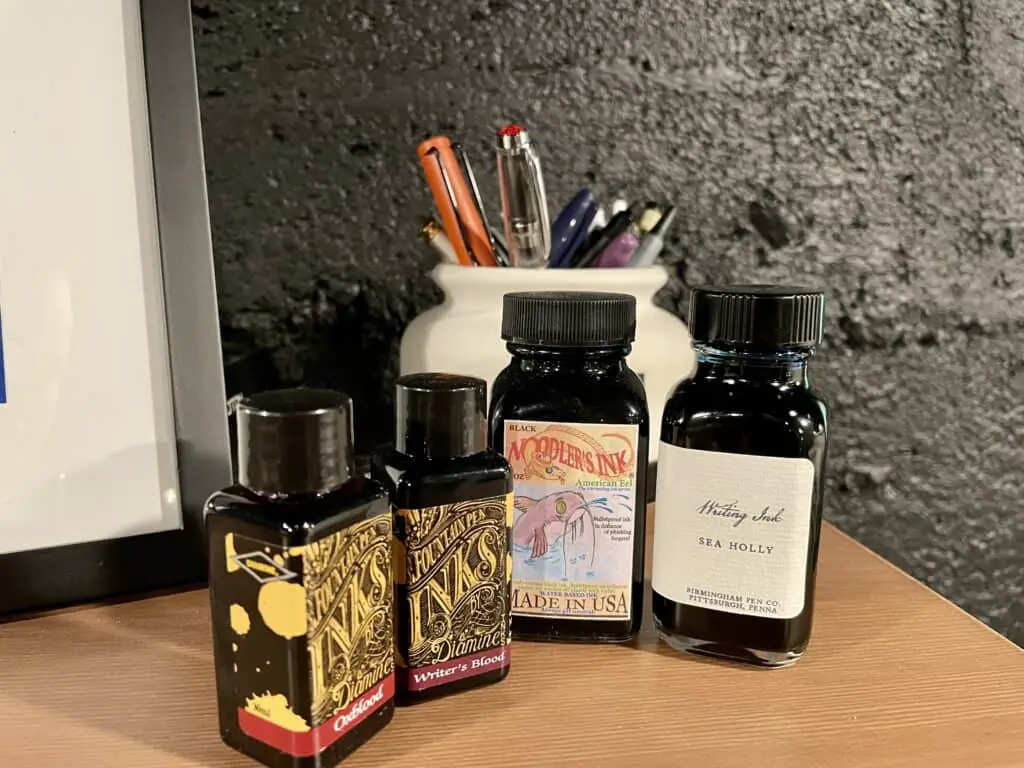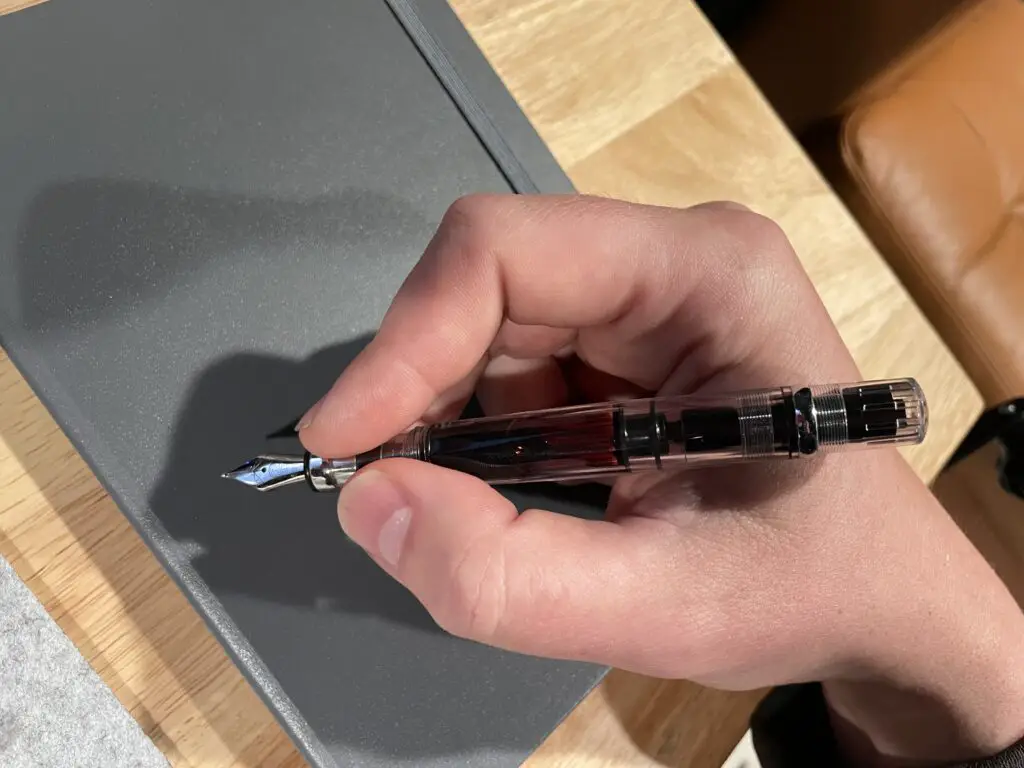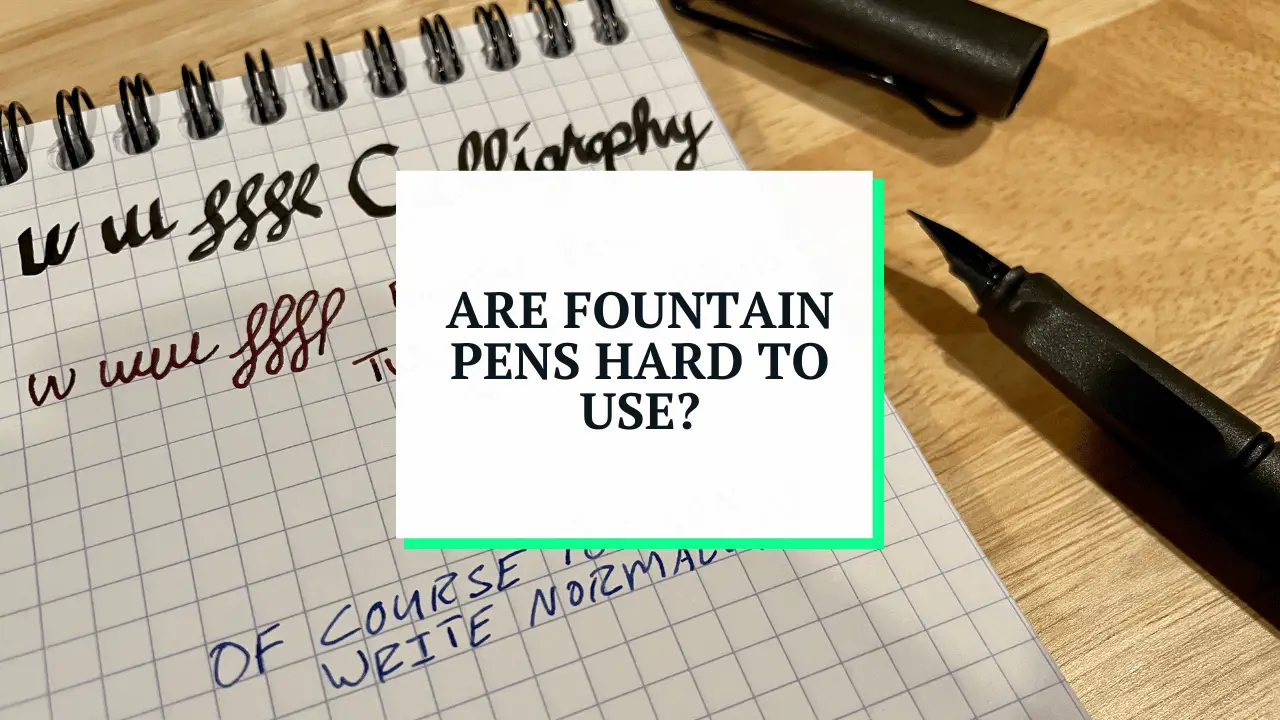Have you ever felt like a quill-wielding wordsmith from the 18th century, penning a masterpiece on parchment paper???
Because that sounds totally annoying, right?
#FountainPens 😎
So that’s the question. Fountain pens are a super fun hobby, but are fountain pens hard to use?
While they may feel different than traditional pens, fountain pens are not necessarily harder to use. Once you get used to the different feel and ink flow, the actual writing isn’t any more difficult than with other pens. In fact, fountain pens require less pressure to release ink, so they can actually be easier to write with.
Fear not, dear reader, we’ve got you covered!
Grab your favorite notebook and let’s dive into if fountain pens are as tricky as they seem.
Are Fountain Pens Hard To Use?
No, they’re not (once you get used to it).

Fountain pens are often viewed as intimidating and difficult to use, but anyone can master them. They’re definitely going to feel different than traditional pens, but the actual writing process is NOT any more difficult.
One of the biggest things that set fountain pens apart is their nib, which is responsible for transferring ink to the paper.
Unlike ballpoint or gel pens, fountain pen nibs are designed to glide across the page, creating a more fluid writing experience. They do NOT need as much pressure on the paper!
This can take some getting used to, especially for those who are accustomed to pressing down on the pen to create bold lines.
Then there’s the ongoing cleaning & maintenance.
Unlike disposable pens, fountain pens require more cleaning and care to keep them functioning properly.
This can involve:
- flushing the pen with water
- changing ink cartridges
- disassembling the pen to clean the nib.
While this extra effort may seem like a downside, many fountain pen enthusiasts ACTUALLY ENJOY the ritual and care that goes into maintaining their pens.
Despite these differences, using a fountain pen is not necessarily hard. It’s just a matter of adjusting to a new writing tool and taking the time to learn how to use it properly!
With practice (and patience), anyone can enjoy the writing experience that a beautiful fountain pen offers.
How To Easily Write With A Fountain Pen
Let’s explore some simple tips that can help beginners get used to writing with fountain pens quickly:
- Hold the pen correctly: One of the most important things to remember when using a fountain pen is to hold it correctly. Place your thumb and index finger near the base of the nib, and rest the pen on the middle finger. Think of a small triangle of fingers, gently holding the pen! This allows for better control and a smoother writing experience.
- Use light pressure: Unlike ballpoint pens, fountain pens require very little pressure to write. Use a light touch and let the pen do the work. This will help prevent the ink from smudging or bleeding, and can improve the overall quality of your writing.
- Practice with different paper types: Not all paper is created equal when it comes to fountain pens. Experiment with different paper types (I prefer 100+ GSM paper weight) to find one that works best for your writing style. Look for paper that is smooth, absorbent, and designed for use with fountain pens. (80+ GSM at least)
- Start with a fine nib: If you’re new to fountain pens, it’s a good idea to start with a pen that has a fine nib. There’s LESS ink going to the paper. This gives you more control and makes it easier to get used to the feel of the pen. As you become more comfortable, you can experiment with broader nibs and different ink colors.

By following these simple tips, beginners can quickly get used to writing with a fountain pen and enjoy the unique writing experience that they offer.
Related post: Can You Write Normally With a Fountain Pen?
Pros And Cons Of Fountain Pens
Like any writing tool, fountain pens have their pros and cons. Here are some advantages and disadvantages to consider:
Advantages Of Using A Fountain Pen
✅ Improved Writing Experience:
Fountain pens offer a smoother, more enjoyable writing experience than other types of pens. The nib glides across the paper, creating a unique and elegant line that is difficult to achieve with other pens.
✅ Unique and Beautiful Ink Options:
Fountain pens offer a wide range of ink colors and styles, from classic blue and black to vibrant shades of pink and green. This variety allows writers to express their creativity and personal style in their writing.
✅ Potential Cost Savings Over Time:
While the initial cost of a fountain pen may be higher than a disposable pen, the long-term cost savings can be significant. Fountain pens can be refilled with ink cartridges or bottles, which are often more cost-effective than buying new pens.
✅ Durability: Fountain pens are built to last.
With proper care and maintenance, a fountain pen can last for years, even decades. This makes them a great investment for anyone who loves writing or appreciates quality stationery.

Disadvantages Of Using A Fountain Pen
❌ Can Be Messier and Require More Maintenance:
Fountain pens require more maintenance than other types of pens. Ink can leak or smudge, and the pen may need to be cleaned regularly to prevent clogs.
❌ Risk of Ink Smudging or Leaking:
Because fountain pens use liquid ink, there is a risk of smudging or leaking if the pen is not used correctly. This can be frustrating for writers who are not used to the unique properties of fountain pens.
❌ Initial Investment Cost Can Be Higher:
High-quality fountain pens can be expensive, which may deter some writers from trying them. However, there are many affordable options available for those who want to experiment with fountain pens without breaking the bank.
*
While they may require some adjustment and maintenance, the benefits of using a fountain pen EASILY outweigh the potential drawbacks–especially once you get used to them!
So what’s the bottom line? Check this post: Are Fountain Pens Better?
How To Hold A Fountain Pen Correctly

Ok fountain pen nerds! The way you hold a fountain pen is CRUCIAL for creating beautiful and elegant lines on paper.
Here are some tips:
The “Normal” Fountain Pen Grip
The correct grip for holding a fountain pen is kinda like a fancy handshake. You wanna place your thumb and index finger near the base of the nib, and rest the pen on the middle finger. This allows for better control and a smoother writing experience.
Your fingers make a triangle!
Tips For Finding The Right Grip For You
Finding the right grip for you is a bit like dating – you gotta experiment to find your perfect match.
Try holding the pen at different angles and positions until you find one that feels natural and comfortable. It’s ok to break the rules sometimes! This will take time and experimentation, but the effort is worth it!
Why Grip Matters 😎
A proper grip can help prevent hand fatigue and cramping, allowing you to write for longer periods without discomfort.
Plus, there’s what your handwriting LOOKS LIKE. Holding the pen correctly can help improve the quality of your handwriting by giving you better control and precision. So, don’t be a slouch – hold that pen like a boss and watch your writing skills soar 😉
Fountain Vs Gel Vs Ballpoint Pens: A Comparison
Fountain pens, gel pens, and ballpoint pens are all popular writing tools, but they differ in several aspects. In this section, we will compare these pens based on their writing experience, practicality, and cost.
Writing Experience
- Fountain Pens: Fountain pens offer a smooth and fluid writing experience due to their nibs, which glide effortlessly across the paper. This allows for a more personalized writing style and can reduce hand fatigue. Fountain pens require minimal pressure to write, making them ideal for those who have a light touch.
- Gel Pens: Gel pens are known for their consistency and offering a wide variety of fun ink colors.. They are also smooth, and perfect for creating crisp and sharp lines. Gel pens are also available in a variety of colors, making them suitable for artistic and creative use.
- Ballpoint Pens: Ballpoint pens are dependable and practical. Read: Cheap. They use a fast-drying ink that is suitable for most writing tasks. Ballpoint pens have a fine point that provides precision, making them ideal for handwriting that requires precision and accuracy.
Practicality
- Fountain Pens: Fountain pens require more maintenance than other pens. They need to be refilled with ink, and the nibs need to be cleaned regularly. While they require more effort, many fountain pen enthusiasts enjoy the ritual and care that goes into maintaining their pens.
- Gel Pens: Gel pens are sometimes refillable and require minimal maintenance, though most gel pens are disposable as well. They offer a convenient option for those who want a reliable pen without the hassle of maintenance.
- Ballpoint Pens: Ballpoint pens are the most practical and straightforward option. They do make fancier ballpoint pens, but the vast majority are single use, cheap, and easy!
Cost
- Fountain Pens: Fountain pens can be more expensive than other pens, especially high-end brands. However, they offer long-term cost savings because they can be refilled with ink cartridges or bottles, which are often more cost-effective than buying new pens.
- Gel Pens: Gel pens come in a range of prices, from affordable to expensive. While they require regular ink refills, they are not as expensive as fountain pens.
- Ballpoint Pens: Ballpoint pens are the most affordable and widely available option. They are ideal for those who want a reliable and practical pen without spending too much money.
Conclusion
No, fountain pens aren’t necessarily any more difficult to write with!
While they may require some adjustment and maintenance, the benefits of using a fountain pen, such as improved writing experience, a TON of fun ink options, and durability, can outweigh the potential drawbacks!
So if you’re been wanting to grab your first fountain pen, do it!
Welcome to the fountain pen rabbit hole 😉
Fountain Pen F.A.Q.s
How Do I Clean And Maintain My Fountain Pen?
To clean your fountain pen, you’ll need to disassemble it and rinse the nib and feed under running water. You can also use a cleaning solution (vinegar) to remove any stubborn ink residue that may have dried. To maintain your fountain pen, it’s important to use it regularly and store it properly when not in use.
What Are Some Affordable Fountain Pen Options For Beginners?
Some affordable fountain pen options for beginners include the Pilot Metropolitan, Lamy Safari, and Kaweco Sport. These pens offer good quality at a reasonable price, making them a great choice for those new to fountain pens.
Can I Use Any Ink With My Fountain Pen?
While most fountain pens can use a wide variety of ink types and brands, it’s important to check your pen’s specifications to ensure that the ink is compatible. Additionally, using a non-recommended ink can sometimes damage the pen or clog the nib, so it’s important to do some research before trying a new ink.
How Do I Store My Fountain Pen When I’m Not Using It?
To store your fountain pen when not in use, it’s best to keep it in a pen case or sleeve to protect it from dust and damage. It’s also a good idea to store it horizontally or with the nib pointing upward to prevent ink from pooling and potentially clogging the nib.
Related post on fountain pen storage here!
Do I Need To Use Special Paper With My Fountain Pen?
While fountain pens can write on a variety of paper types, using high-quality paper can help prevent bleeding and feathering of the ink, which can affect the appearance of your writing. Look for paper labeled as “fountain pen friendly” or “ink-resistant” for the best results. Use a gsm (the weight of the paper) of at east 80+, and preferably 100+ gsm for wetter inks.
Can Left-handed People Use Fountain Pens?
Yes, left-handed people can use fountain pens, but they may need to experiment with different grips and nib sizes to find the most comfortable writing position. Some fountain pen brands also offer left-handed nibs, which have a different angle to reduce smudging.
